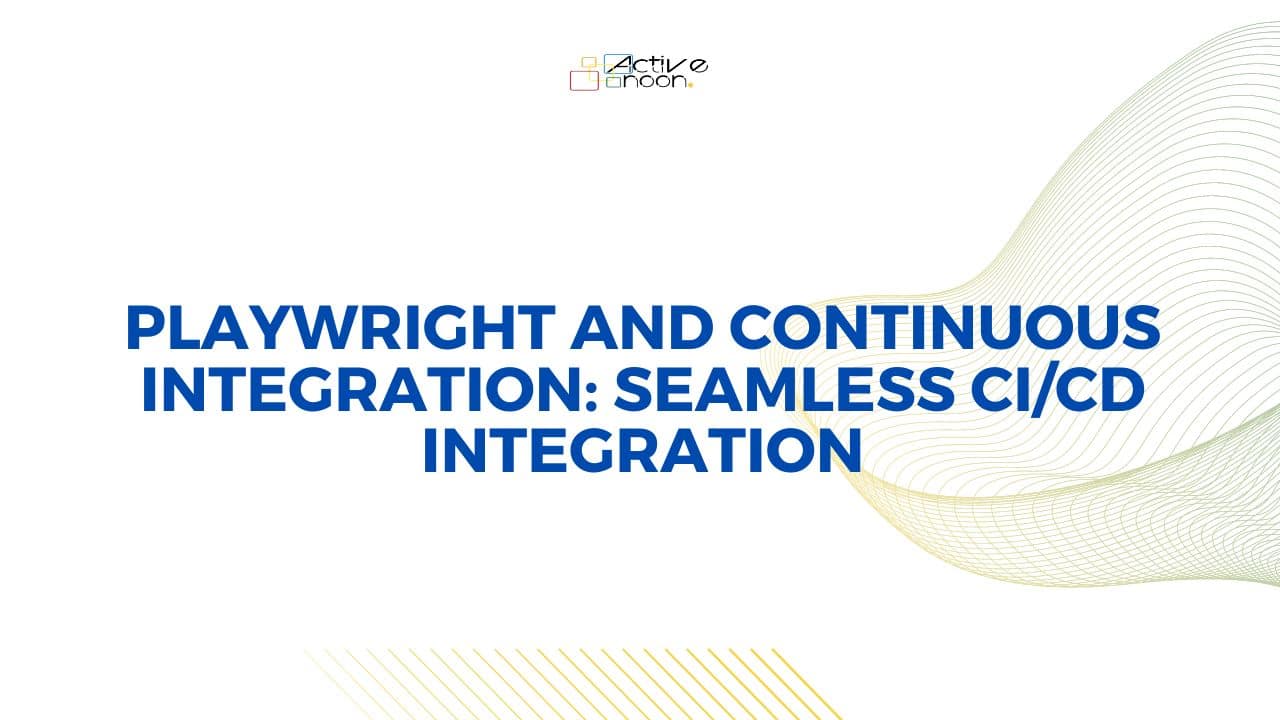In this rapidly evolving software development industry where speed, reliability and efficiency are of paramount importance, automation and integration form the cornerstone of success. The core concept of such a connection revolves around Continuous Integration/Deployment (CI/CD), a strategy that allows developers to provide quality codes at a higher speed while at the same time ensuring the integrity of software systems. However, attaining a real CI/CD serenity needs more than adopting the right tools because it takes all together development and testing skills.
Here comes Playwright, the world-famous automation framework of the future, that has made a huge impact on the field of automated testing. Having the capability to navigate through the web applications and imitate user interactions across different browsers, Playwright has become an excellent tool for teams willing to upgrade their quality assurance processes to a higher level. However Playwright is not just in usage as a separate tool, but also in its smooth incorporation into CI/CD pipelines.
In this blog we are going to cover the issue of the merge of Playwright with Continuous Integration, describing the wonders of combining this powerful testing tool to CI/CD processes.
Continuous integration (CI) and Continuous deployment (CD)
CI and CD are two key practices in modern software development, often supported by the Agile methodology. CI consists of repeatedly putting code changes to a shared repository, which runs automated builds and tests to maintain the quality of code. CD goes a step further than CI by enabling the automation of the deployment process, and then allowing validated code changes to be automatically deployed to production environments, thereby encouraging the quick and continuous distribution of updates or new features to the end-users.
Main Elements and Outcomes of CI/CD Pipelines
CI/CD pipelines include multiple components, e.g., version control systems (like Git), automated build systems (such as Jenkins or GitLab CI), automated testing frameworks, and deployment orchestration (Kubernetes or Docker).
First of all, CI/CD pipelines bring along a host of advantages. They include:
- Faster Time-to-Market: Automated pipelines for build, test, and deployment enable fast delivery of new features and software updates.
- Improved Quality: Automation of testing within CI/CD pipeline ensures that code changes are fully examined, decreasing the possibility of bugs and errors in production.
- Enhanced Collaboration: CI/CD enhances the collaboration of the development, QA and operations teams, which results in a culture of transparency and shared responsibility.
- Increased Confidence: Through automated testing and deployment, developers gain more confidence in their code changes’ reliability and stability and there is a more frequent update.
Integration Issues in Continuous Integration/Continuous Delivery Processes into Development Processes
With all the positive impacts of CI/CD integration in the software development process, there are also certain obstacles that come along. These may include:
- Cultural Resistance: CI/CD implementation requires organizations to make a cultural shift as it demands new workflow, positions and roles. Change of apprehension of the stakeholders will hamper successful implementation.
- Complexity of Legacy Systems: Legacy systems could be lacking in the foundation and the architecture needed to successfully integrate CI/CD pipelines, thus making the integration more challenging and longer to complete.
- Ensuring Consistency: Ensuring consistency for the various environments (development, staging, production) is a hard task, especially when you have a lot of dependencies and config settings.
- Security Concerns: Automation of software deployment brings with it the issue of security weak points and compatibility with regulatory legislations. Establishing strong security within the CI/CD pipelines is no less than a prerequisite for curtailing risks.
Introduction to Playwright
Playwright is an innovative part of the new line of automated frameworks and takes the testing process to the next level of development. Developed by Microsoft, Playwright is the new open-source testing tool that gives developers a way to automate interactions with the web applications through different browsers on multiple platforms.
Yet, what makes Playwright unique is its flexibility in supporting such browsers as Chrome, Firefox, and Safari besides headless environments and mobile devices. Developers can code tests using their preferred programming languages, including Javascript, TypeScript, Python, and so on and go beyond the frontiers of different development ecosystems with Playwright.
Characteristics and Functions of the Playwright for Automated Testing
- Cross-Browser Testing: With the help of Playwright, developers now can simulate tests across multiple browsers at the same time, making the outcome same in different environments.
- Headless Execution: Unlike Selenium which does browser testing on real browsers, Playwright integrates support for headless browser testing and scaled test execution for its integration into CI/CD pipelines and automated testing workflows.
- Rich API: The playwright has an elaborate API for communication with the browser, allowing developers to mimic user actions such as clicks, typing, navigation, and more with exacting levels of accuracy.
- Snapshot Testing: The test tool called Playwright simplifies visual regression testing by adding snapshot testing ability to the product. It offers capturing screenshots and compares them to baseline images so that the devs can detect visual differences.
- Network Interception: Playwright offers interception and modification of network requests which is a very powerful feature and it can help carry out advanced testing scenarios such as mocking API responses and simulating network conditions.
- Device Emulation: Playwright implements the device emulation feature to test apps in various devices and screen sizes thus guaranteeing an equivalent user experience in both desktop and mobile devices.
The position of Playwright in Testing environment
Playwright is so adaptable and extremely capable that it can satisfy changing testing requirements of a developer and the quality engineers. The module’s high level of flexibility, scalability and robust feature set are just some of the things that make it well-suited for a wide variety of testing scenarios such as functional, regression, performance and any other type of testing.
The platform offers integration capabilities into testing frameworks currently used and CI/CD pipelines, hence, developers can automate the testing processes and facilitate expedited software release without compromising on quality. In the face of agile approaches and a driving force to improve performance, Playwright acts as the underpinning of the testing strategy for organizations and provides a mechanism for delivering high-quality software faster and on a bigger scale.
To achieve success for a playwright, continuous integration is essential
The fact that Playwright is a powerful tool for automation testing is what makes it the best choice for bringing in automation testing into the CI/CD pipelines. Browser compatibility, headless execution, and the rich API providing developers with the opportunity to automate UI testing across different environments without any hassle.
In addition, Playwright’s support for various languages allows teams to incorporate the skills they already have into the process; this lowers the learning curve and expedites adoption of the technology. By incorporating Playwright into CI/CD processes, teams can be sure that every code change goes through a comprehensive validation for faster delivery as compared to the previous process which offered improved software quality.
Utilization of Playwright for Automation in UI Testing in CI/CD Pipeline
The UI testing of web applications, which is an important part of the CI/CD pipelines, is meant for verifying the functionality and user experience of these web applications. With the variety of features in Playwright, from cross-browser testing to headless execution and device emulation, it is an excellent choice for the purpose in question.
Using the Playwright API in CI/CD processes, the team can automate UI testing for the browsers and platforms, achieving parallel behavior and compatibility. Using this automated verification tool not only reduces the risk of making such bugs but also provides quicker feedback to the developers and thus they can keep on iterating and meeting test requirements with confidence.
Recommended Approaches for Playwright to Communicate with CI/CD Systems and Workflows
Adoption of the Playwright tools into the CI/CD pipelines depends on scrupulous planning and adherence to the best practices in order to have the pipelines run smoothly and efficiently. Some best practices include:
- Version Control: Collect the scripts for store playwright scripts and application code in version control repositories to maintain traceability and support collaboration.
- Parallel Execution: Utilize the parallel execution of Playwright tests to run the tests at the same time and reduce the overall testing time with increased throughput as a result.
- Environment Configuration: Make sure that all CI/CD stages adhere to identical environment configurations in order to avoid any discrepancies and ensure accurate test results.
- Test Reporting: Enable effective test reporting system to keep records of test execution details and capture failures urgently, thereby promoting quick troubleshooting and closure of feedback loops.
- Integration with CI/CD Tools: Plug Playwright into the CI/CD tools like Jenkins, GitLab CI, or Azure DevOps by employing pre-existing plugins and custom scripts to run test instances automatically and present test results.
The Troubles of CI/CD Integration with Playwright
Many traders of continuous integration/continuous delivery (CI/CD) integration with Playwright may experience several common obstacles that threaten to impede the success of automated testing workflows. These include:
- Inadequate Test Coverage: Sticking only to UI test cases creation with Playwright may lead to missing some major features in one’s application. To mitigate this risk, teams must make use of the balanced testing approach which will include unit testing, integration testing, and end-to-end testing.
- Fragile Test Scripts: The test scripts that are dependent on specific UI elements or dynamic content are most liable to get breakage and thus need regular maintenance. This can be circumvented by producing dependable tests with strong selectors and by reacting elegantly to dynamic scenarios.
- Long Test Execution Times: Time-consuming test executions prevent CI/CD pipes from flowing smoothly and decrease development speed. Optimizing test scripts for speed, parallelizing test execution, and prioritizing important tests among others may help with the mentioned problem.
Techniques for Dealing with Fake Tests and Establishing Dependable CI/CD Pipelines
- Flakey tests which have an inconsistent result are considered the biggest problem in CI/CD integration with Playwright. Here’s how you can deal with it.
- Test Environment Stability: Make the test environment remain stable and consistent, which minimizes the variability in the test results that may be caused by some environmental factors.
- Retry Mechanisms: In place of implementing re-do mechanisms for flaky tests that rerun them automatically failing, this will produce fewer false positives and produce more reliable results.
- Test Data Management: Provide steady and forecastable test driven data that will in turn limit the effect of data on test reliability.
- Failure Analysis and Reporting: Invest in the creation of robust failure analysis and reporting tools to identify and fix automated testing problems quickly, so that teams can reach and sustain reliable CI/CD pipelines.
Improvement and efficiency of playwright-based CI/CD workflow.
In Playwright-based CI/CD workflows, performance and efficiency optimization processes are the things necessary for the organizations to get effective work and the least amount of overhead. Those are as followed:
- Test Parallelization: Parallelize test execution on multiple machines and in a container to spread workload and lessen overall testing time.
- Headless Execution: Use headless mode for tests that do not need a graphical interface to reduce the execution time, resource requirements.
- Resource Management: Eliminate resource constraints for test execution environments by providing enough resources that can be used simultaneously during testing.
- Test Case Prioritization: Make sure that you pick important test cases so that all important functionalities are tested first and you get quick feedback on bigger changes.
- Continuous Monitoring and Optimization: Constantly measure test execution performance of the pipeline and identify the problem areas then provide optimizations in the loop.
Conclusion
This blog has explained the symbiotic relationship between Playwright, CI/CD. We have already explored how the CI/CD incorporates Playwright’s automation capabilities to make it easier for teams to seamlessly automate UI testing. We have included detours to common pitfalls and suggested ways of conquering challenges, thus highlighting the significance of efficient CI/CD integration for the development teams’ agility, collaboration, and innovation.
The real-time CI/CD integration along with LambdaTest cross-browser testing is no longer just an advantage; in fact, it is a necessity which you need in today’s swift software creation landscape. Automating the build, test, and deployment processes with CI/CD pipelines on LambdaTest, an AI-powered test orchestration and execution platform helps organizations install software updates promptly and to perfection; witnessing competitiveness and building the culture of constant improvement. Using Playwright and LambdaTest for testing and delivering processes equips organizations to speed up delivery cycles and also to maintain high code quality, thus ensuring positive user experience through quality software, hence the future of software development is being shaped.

















Leave a Reply